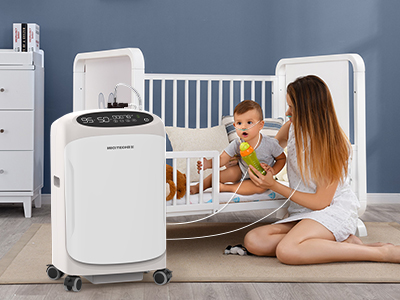28 Mar 2025
In modern healthcare, oxygen therapy is a non-negotiable element of patient survival. From emergency departments to intensive care units, a reliable supply of medical oxygen is crucial for treating respiratory distress, trauma cases, and chronic illnesses. However, the increasing reliance on oxygen concentrators has also highlighted a critical vulnerability—what happens when oxygen supply is disrupted?

Backup oxygen concentrators serve as a vital safeguard, ensuring that hospitals maintain an uninterrupted flow of oxygen during emergencies. A single failure in oxygen supply can result in catastrophic consequences, particularly for critically ill patients. Hospitals must be equipped with redundant oxygen sources to counteract potential shortages, power outages, or logistical failures.
Understanding the Function of Oxygen Concentrators
Oxygen concentrators function by extracting oxygen from ambient air, filtering out nitrogen, and delivering a purified stream of medical-grade oxygen to patients. Unlike traditional oxygen cylinders that store a finite amount of oxygen under high pressure, concentrators generate oxygen on demand, making them a sustainable and efficient alternative.
Hospitals benefit from concentrators due to their continuous operation, cost-effectiveness, and reduced dependency on external suppliers. These devices play a particularly crucial role in intensive care settings, where oxygen delivery must remain uninterrupted. However, even the most advanced concentrators require contingency plans to ensure functionality during system failures.
The Risks of Oxygen Supply Disruptions in Hospitals
An interruption in oxygen supply can be life-threatening, particularly in critical care environments. Hospitals face several risks that could compromise oxygen availability, including:
Power outages – A sudden loss of electricity can disable concentrators and ventilators, leaving patients in immediate distress.
Supply chain disruptions – Global health crises, natural disasters, or logistical failures can delay oxygen deliveries, causing severe shortages.
Infrastructure malfunctions – Centralized hospital oxygen supply systems can fail due to maintenance issues, equipment breakdowns, or human error.
Several case studies have demonstrated the devastating impact of oxygen shortages. During the COVID-19 pandemic, hospitals worldwide faced oxygen depletion crises, leading to unnecessary fatalities. Such events underscore the urgent need for backup oxygen concentrators as a safeguard against unpredictable emergencies.
The Role of Backup Oxygen Concentrators in Emergency Preparedness
Every hospital must have a robust emergency preparedness plan that includes redundant oxygen supply systems. Backup oxygen concentrators play a pivotal role in:
Maintaining uninterrupted oxygen therapy during unexpected supply disruptions
Preventing patient deterioration by ensuring seamless oxygen delivery in ICUs and emergency wards
Supporting disaster management strategies in healthcare facilities, ensuring rapid deployment of additional oxygen sources
A well-equipped hospital cannot afford to rely solely on primary oxygen systems. Backup concentrators bridge the gap during crises, ensuring that life-saving oxygen remains available at all times.

Advantages of Oxygen Concentrators Over Cylinders in Backup Systems
While oxygen cylinders have traditionally been used as emergency reserves, they come with significant limitations. Backup oxygen concentrators offer several advantages over cylinders, including:
Continuous oxygen generation – Unlike cylinders, which require refilling, concentrators produce an ongoing supply of oxygen.
Lower logistical burden – Hospitals no longer need to manage frequent cylinder replacements or worry about stock depletion.
Cost-effectiveness – Over time, concentrators reduce operational costs by eliminating repeated purchases of oxygen tanks.
Given these benefits, hospitals should prioritize integrating backup concentrators alongside traditional oxygen storage methods for a more resilient emergency oxygen strategy.
Integration of Backup Oxygen Concentrators in Intensive Care Units (ICUs)
ICUs house patients who are highly oxygen-dependent, including those on ventilators, neonatal units, and patients recovering from respiratory failure. A loss of oxygen in an ICU setting could be fatal within minutes.
Backup oxygen concentrators serve as a fail-safe mechanism, ensuring:
Immediate oxygen availability in case of power or system failure
Stable oxygen supply for ventilator-dependent patients
Protection for vulnerable groups, such as premature infants and critical COVID-19 patients
By integrating backup concentrators into ICU protocols, hospitals fortify their critical care infrastructure against unforeseen emergencies.
Portability and Accessibility: Expanding Emergency Capabilities
Beyond stationary concentrators, portable backup oxygen concentrators are an invaluable asset for hospital preparedness. These compact units provide:
Rapid deployment during mass casualty incidents
Oxygen support for patient transport within hospitals
Accessibility in resource-limited and remote medical facilities
Hospitals that maintain a fleet of portable backup concentrators ensure that oxygen is readily available whenever and wherever it is needed most.
Technological Advancements in Backup Oxygen Concentrators
The evolution of oxygen therapy has led to the development of smart backup concentrators that incorporate:
Automated oxygen flow adjustment based on patient demand
Integration with hospital power backup systems for seamless operation during outages
Real-time monitoring and predictive maintenance alerts to prevent unexpected failures
These advancements enhance the reliability and efficiency of hospital emergency oxygen supply systems, ensuring sustained patient safety.
Regulatory and Compliance Considerations for Backup Oxygen Systems
Hospitals must adhere to strict regulatory guidelines regarding emergency oxygen supply. Key considerations include:
Compliance with healthcare accreditation standards requiring backup oxygen sources
Implementation of redundancy protocols for critical care oxygen delivery
Regular maintenance and safety checks on backup concentrators
Failure to comply with these standards can result in legal and ethical ramifications, making it imperative for hospitals to establish well-documented emergency oxygen plans.
Conclusion
Backup oxygen concentrators are not just an option—they are a necessity for every hospital. Their ability to ensure continuous oxygen supply, enhance emergency preparedness, and improve patient outcomes makes them an indispensable component of modern healthcare.
Hospitals that invest in robust oxygen backup strategies reinforce their resilience against crises, ensuring that no patient suffers due to oxygen deprivation. As medical technology advances, integrating backup oxygen concentrators will remain a cornerstone of lifesaving emergency care.
Keywords: oxygen concentrator
Originally published 28 Mar 2025, updated 28 Mar 2025.